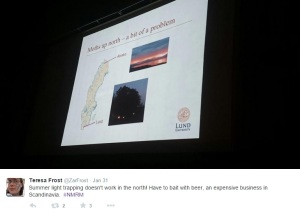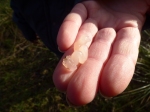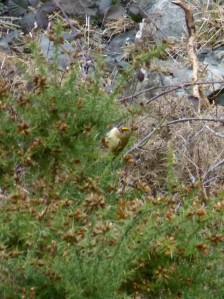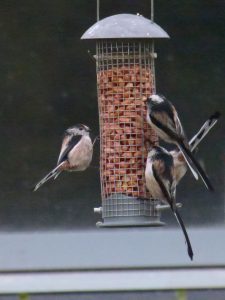Springing back into action
Spring is well and truly underway – birds are nesting, butterflies are fluttering and flowers are blooming. However, before I get on to all that, I’m going to take this blog indoors as I recount a recent event I attended. You may remember that I went to the National Moth Recorders’ Meeting back at the end of January. Well, last weekend I attended a very similar event – the National Butterfly Recorders’ Meeting. There were quite similar talks to NMRM, but with a butterfly slant instead (obviously – it does what it says on the tin); an update on the recording schemes, what the data has been used for, some of the practical work being done to conserve species, and the like. All incredibly interesting, and it was lovely to catch up with various Butterfly Conservation staff and other people I’ve met round and about the place. Despite the achingly-early start (up at 5am, I still shudder thinking of it), I definitely don’t regret spending my birthday there!
As you can see in the last photo, I chose an epic t-shirt to wear for the day – it’s designed by Beth Aucott, and I requested purple because I dislike white clothing for the most part (I’m too pale to wear white). She does a variety of awesome designs, but naturally my choice had to be Lepidoptera!! PS – don’t you just love my earrings too? Thanks Ellen for agreeing with me when I deliberated about buying them!
On the way back through Birmingham New Street Station, I couldn’t resist stopping to take a photo of the signs about the renovation works taking place. I had admired them previously, and they were perfectly matched to the theme of the day! Kudos to the designer for (a) making it nature themed and (b) the general awesomeness of them!
- Going …
- … going …
- … gone!
Back to my local park in north London – I had taken my camera along on a dog walk, hoping to snap a photo of the Ring-necked Parakeets (Psittacula krameri) that had been investigating a tree. However it seems they haven’t gone for nesting here just yet, no squawking green parrots about! I’ll check back of course, but for now, you can have a photo of the hole they had been in and out of previously. Whilst checking out the trees, I noticed some birds circling high up – Buzzards (Buteo buteo – which by the way, is an awesome scientific name and appeared recently on an episode of University Challenge)! Yes, relatively common birds I know, but I had not seen them from the park before so I was pleased (remember, I’m normally looking down for insects, not up for birds of prey!).
- Not about this time
- Circling too high for a decent photo
- Spring is here!!
I found another fallen tree to dig into, much to the chagrin of its occupants. As before, my dog wasn’t too fussed by this pause – he loves having a wander round sniffing everything and chewing sticks. He was little annoyed when I made him stay still so I could take a photo of the micro-moth (possibly Diseriocrania subpurpurella) on his head!
- Intriguing holes
- A couple of upside-down beetles
- Spider unimpressed by me disturbing it
- Web? Fungus?
- Micro-moth (possibly Diseriocrania subpurpurella)
A day trip to Dorset (yes you read that right, I was mad enough to drive to Dorset and back in a day) ensued later in the week, and whilst it wasn’t wildlife-focussed, I managed to squeeze in a quick walk at RSPB’s Radipole Lake where I ticked off a lifer! Very distant, but definitely a Marsh Harrier (Circus aeruginosus)! Nice one! And what a lovely looking bird!
As you may have noticed in recent posts, I’ve been visiting Cambridgeshire a bit, and this week was no exception. A gorgeous sunny Thursday afternoon resulted in Matt spotting a Comma butterfly (Polygonia c-album) – a first of the year for both of us, though he is claiming the record. Fair enough since he spotted it first. As you can see from the photos, it was a very obliging individual allowing me to take a number of photos in a variety of positions. The last photo is particular useful – take a look at its legs. You’ll see that a pair at the front, resting on the wooden surface of the bench. I believe that those are actually its middle pair of legs. The family (Nymphalidae) that this species is in have smaller front legs (naturally there are a couple of exceptions, but not in the UK as far as I know), though I haven’t discovered why just yet. You can see those reduced pair pressed against the front of its body.
- Sunning itself on the bench
- Attempting to blend in amongst the leaves
- From underneath
- Note the front legs here
The garden being so lovely here, there are plenty of birds about. There were even four Greenfinches (Carduelis chloris) at one point! This species has seen a dramatic reduction in numbers, recently due to a parasitic disease called trichomonosis that means the birds cannot feed properly. More information (thanks to the Wildlife Trust for Bedforshire, Cambridgeshire and Northamptonshire) at this link here.
NB – if you have bird feeders – make sure you clean them out so as to limit the spread of this disease.
Talking of dead birds (kind of), I had an incredibly romantic gift from Matt … a dead Great Tit (Parus major)! Most people would be repelled by such a gift I know, but dead creatures are very useful for learning more about anatomy and the like, and for education purposes. And naturally I wouldn’t kill a bird myself (btw, Matt didn’t kill it either, he found it dead nearby) – I make use of natural / accidental deaths.
- Eyeing me up …
- … I’m evidently not a threat, back to the food!
- Poor thing 🙁
Very excitingly, we did some gardening! Mainly sowing some wildflower seeds – as neither had done much of this, it was a bit of guesswork, but I do believe we’ve done it right! And whilst the photo published is of Matt digging, I also contributed to the hard work. Mind you, in my typical fashion, I did keep getting distracted by what we were digging up – there were lots of little beasties in the soil! And yes, my trousers have crabs on them – they are awesome trousers and I love them.
- Matt hard at work
- The first beastie to be found
- Keeping an eye on those pincers
- All curled up
- A fast-moving beastie!
































































































































































































































